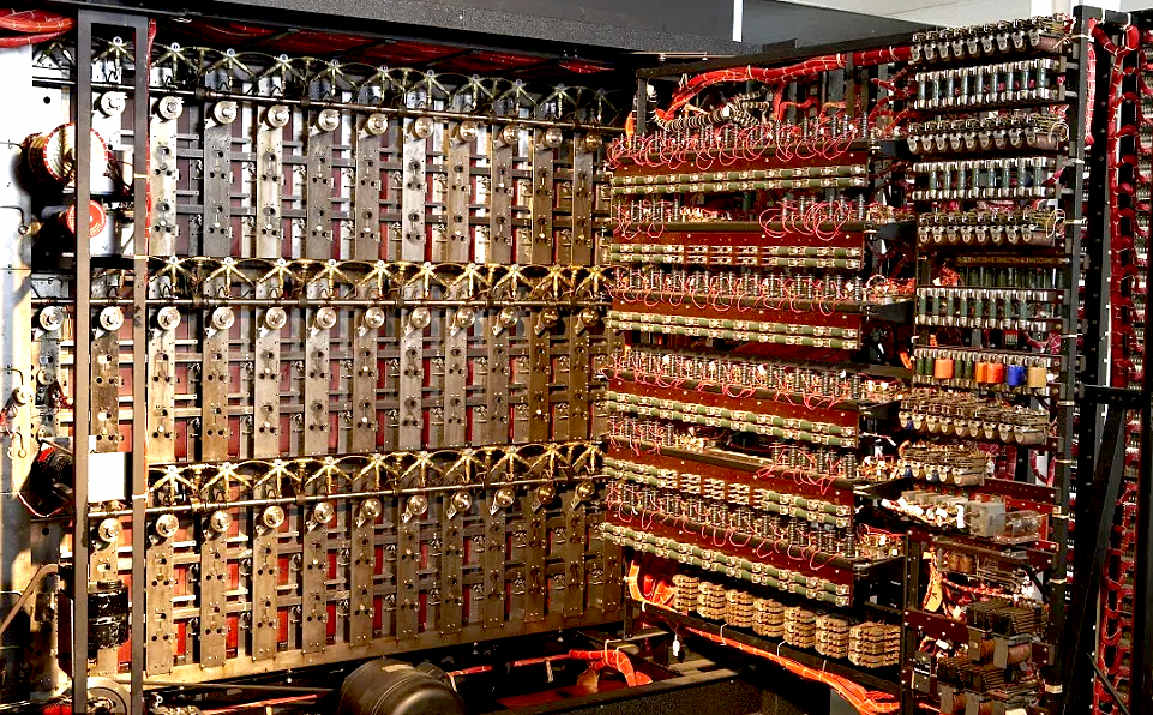|

The
birth of modern computing & Cyber Wars
A Enigma was a machine
invented by the Germans to generate random codes for radio
messages during World
War Two, to make the military contents safe from eaves
droppers. Whereby, another Enigma machines and the code
settings were needed to decipher a message.
The
allies captured an Enigma machine, which, Alan Turing, a
brilliant computer analyst used as the basis for his
research into ways of cracking the coded messages. The aim
being to win the war, by knowing the moves of the enemy in
advance of a battle, or to develop winning strategic
campaigns. Alan designed and built the Colossus, a giant
mechanical logic engine, the basis of modern computing in
principle, awaiting the invention of the microprocessor.
This
was the first use of computers to hack enemy communications,
the forerunner of the Cyber Wars to come.
CODES
& CIPHERS
The terms codes and ciphers are very different. A code changes the meaning of a word or phrase by replacing it with a different word or phrase to make a message secret. A cipher, on the other hand, makes a word or phrase secret by changing or rearranging the individual letters in a message. Together, codes and ciphers are called encryption.
ENIGMA was a cipher machine—each keystroke replaced a character in the message with another character determined by the machine’s rotor settings and wiring arrangements that were previously established between the sender and the receiver. For additional security, the German military services usually double-encrypted their messages by first substituting original text with code words and then enciphering the encoded text.
In the early years of WWII, Turing worked at Britain’s code breaking headquarters in Bletchley Park. In addition to mathematicians, Bletchley Park also recruited linguists and chess champions, and attracted talent by approaching winners of a complex crossword puzzle tournament held by The Daily Telegraph.
Turing’s mathematical and logic skills made him a natural cryptanalyst. Whereas cryptographers write encryption systems, and cryptologists study them, cryptanalysts like Turing break them. In 1939, Turing created a method called “the bombe,” an electromechanical device that could detect the settings for ENIGMA, allowing the Allied powers to decipher German encryptions. Turing and his colleagues were also able to break the more complicated Naval ENIGMA system, which from 1941-1943 helped the Allies avoid German U-boats during the Battle of the Atlantic.
Poland was actually the first to realize that the solution to breaking ENIGMA would most likely be discovered by a mathematician. Polish cryptanalysts as early as 1932 could decode German ciphers and, by 1939, they were able to successfully decipher messages written with an earlier version of ENIGMA using a replica machine like “the bombe” that could emulate the way ENIGMA worked. When Poland was overrun by Germany in September 1939, the Polish as well as French cryptanalysts shared what they knew about ENIGMA with the UK, which allowed the cryptanalysts at Bletchley Park, including Turing, to finally crack the ENIGMA ciphers.
Turing would spend the majority of his career focused on what would eventually become modern day computing. He was posted to serve with the US Navy’s Cryptanalytic Section for several months in 1943, where he met and discussed mathematical models of communication and computation with Claude Shannon (the father of information theory). To this day, our communications networks are built on top of Shannon’s ideas, while our computing devices, processors, and chips are built upon Turing’s ideas. Turing’s contribution to modern computing was so significant that the prestigious A.M. Turing Award—sometimes known as the “Nobel Prize” of Computer Science—is named after him.
It wasn’t until the 1970s that the story of ENIGMA was declassified and Turing could be recognized for his significant contributions to modern computer science, the world of cryptography, and the defeat of the Axis powers in WWII.
CYBERCORE
GENETICA™
In
this fictional series of John
Storm adventures, the accidental discovery of the CyberCore
Genetica super-nano computer, adds a new dimension to
military and industrial
espionage. Musket Meloni throws all his financial muscle
at hacking into Hal,
the AI onboard the Elizabeth
Swann. Even the richest
billionaire on the planet cannot defeat the combination
of Hal and the CyberCore. Indeed, the virus attack is
reversed, with Meloni's tax records and suspicious
commercial arrangements, being revealed.
The
CyberCore/Hal combination was first used to good effect to
thwart a missile attack on the Swann, with the CIA
and NORAD
being compromised, as the missiles were re-directed to Guantánamo
Bay.
REFERENCE
https://
|
